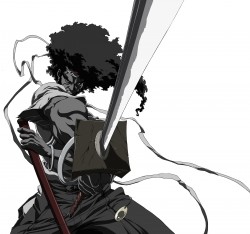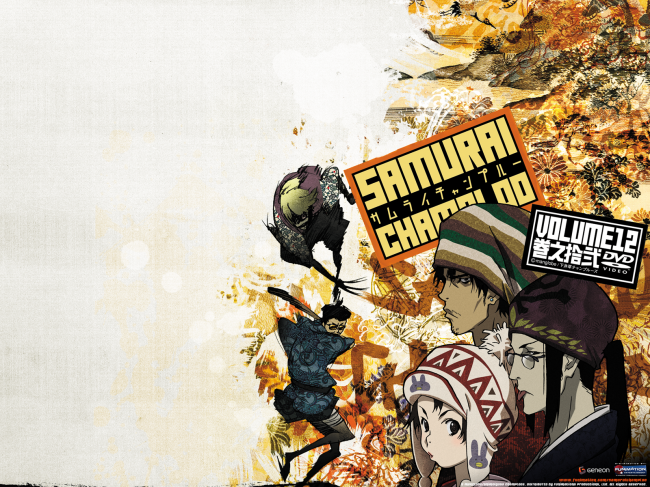
Black Future Month ’10: Paris/Tokyo
February 6th, 2010 by david brothers | Tags: afro samurai, black history month 2010, japan, julian lytle, khari evans, samurai champloo
The easiest thing to point to when someone says “What’s cultural appropriation?” (in the unlikely event that somebody actually wants to know the answer to that question) is the theft of rock and roll. ego trip’s Big Book of Racism!
It isn’t a focused movement, exactly. There are no malicious men sitting around a table, plotting on how they can steal bachata and make it there own. It tends to be a byproduct of what happens when racism and institutional racism work hand in hand. Taking rock and roll for an (extremely simplified) example– white America in the mid-1900s had no interest in letting black America onto their jukeboxes and into their clubs. However, white musicians performing what was often the exact same music was met with, if not acceptance, something more positive than racially-motivated revulsion. Over time, rock and roll became a “white” genre, something associated with your average run of the mill white people rather than blacks.
Blackface is another example of cultural appropriation, though much more actively racist and malicious. White actors portrayed black characters for the entertainment and edification of a white audience, donning burnt cork and shoe polish and emulating (or just making up) the ways that black people acted.
A more recent example of cultural appropriation are the dozens of kung fu movies starring white guys. Once Hong Kong action cinema proved to be popular in the ’70s, one way of making it even more popular for American audiences was to toss a white guy into the main role. A good example of this is Danny Rand, from Marvel’s Iron Fist. Danny is a rich white guy who ended up in a thinly obfuscated Shangri-La and ended up becoming its greatest warrior, even triumphing over the natives of the city.
In the fall of ’08, I took a work trip to Tokyo, Japan. I didn’t get as much time to dig in and explore as I wanted, but I did end up spending a lot of time in Shibuya and Harajuku. I saw a lot of people dressed like I dressed, or like people dressed back home. I spent some time in a streetwear shop where the two clerks didn’t know much English beyond “Biggie” and “Nas,” but they knew rap lyrics and fashion.

I graduated high school in Madrid, Spain, clear on the other side of the globe. While there, again, I fell in with Spanish kids (among other ethnicities) who loved rap. We listened to Frank T and 7 Notas, 7 Colores. We went out breakdancing on weekends and bought markers to tag things up. It was easy to find people who were into rap. Consider Santa Inoue’s Tokyo Tribes, which looks at juvenile delinquents through the lens of rap culture. Or Shinichiro Watanabe’s Samurai Champloo, which was a sublime fusion of chambara cinema, hip-hop aesthetics, and on occasion, black intracultural politics. Both are undeniably Japanese, but at the same time, instantly relatable.
Tokyo and Madrid: two cities several thousand miles away from where rap culture was born, and completely different racially and culturally, but whose children have embraced it wholly. Are they pantomiming and appropriating the culture or are they simply appreciating? Where is the line drawn?
You ever seen a Shaw Bros. movie? ’cause you just watched an homage.
Most of the traditionally nerd stuff I’m into, stuff that gets pushed on so-called “geek” blogs, wasn’t nerdy when I was growing up. Comic books and video games? Everybody read those, and everybody practiced so that they could jump the bridge in Contra or figured out money plays in Tecmo Football so they could show off. Normal black people, not nerds or geeks, were the ones who put me onto comics, video games, and, yes, even anime. I’ve spoken to a gang of black people my age who got put onto anime early, whether it was Akira, Fist of the North Star, Speed Racer, or Ninja Scroll. It’s normal.
You can look at the Wu-Tang Clan and see this at work. They’ve blended Hong Kong cinema and black culture and created something that feels natural and interesting. It’s not an attempt to steal the culture, though the Wu have definitely used that mythology and made it their own. It’s more of an appreciation and a natural evolution.
Now, more than ever, cultural appropriation isn’t as simple as one culture co-opting another’s media and styles. The races aren’t as monolithic as they once were, or seemed to be to outsiders, and that cultures often mix and blend along funny lines. We live much closer to each other now, and our kids go to the same schools and listen to the same music.
The Boondocks is a perfect storm of this cross-cultural influence. In any single episode, you can see an even mixture of Hong Kong cinema, Japanese animation, hip-hop, soul, newspaper comics, Civil Rights-era politics, and Richard Pryor-style humor. This is normal to McGruder, not something he has co-opted from elsewhere.
You can see this at work in a lot of black artists, too. Whether influenced by anime or Japanese culture and art in general, people like Ron Wimberly, Julian Lytle, Khary Randolph, Khari Evans, and LeSean Thomas are putting stuff out there that doesn’t look like anything else. For that matter, white artists like Jim Mahfood and Skottie Young have styles that practically bleed rap.
That’s cultural fusion at work, not appropriation. After a certain measure of immersion, “our” culture becomes our culture, you know? The arbitrary boundaries between races and cultures are nowhere near as strong, or perhaps prevalent, as they used to be, and it reflects in the art people create. “Normal” is being redefined faster than ever now that the world is moving faster in a smaller space. And that’s what post-racialism actually is- people coexisting and living together, embracing their differences and similarities, and sharing all of it. You can’t force it and you can’t declare it. It happens as things get better.

Good stuff right here in this article. BHM is off to a good start.
Also David you seen the Japanese opening for the Boondocks?
http://www.youtube.com/watch?v=DptarLqEmuE
exactly